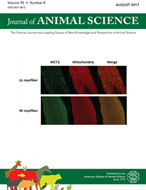-
Views
-
Cite
Cite
M. Kouba, M. Enser, F. M. Whittington, G. R. Nute, J. D. Wood, Effect of a high-linolenic acid diet on lipogenic enzyme activities, fatty acid composition, and meat quality in the growing pig, Journal of Animal Science, Volume 81, Issue 8, August 2003, Pages 1967–1979, https://doi.org/10.2527/2003.8181967x
Close - Share Icon Share
Abstract
Forty-eight Duroc-cross gilts (40 kg initial BW) were fed a control or a linseed diet containing 60 g of whole crushed linseed/kg. Both diets were supplemented with 150 mg of vitamin E/kg. Eight pigs from each dietary treatment were slaughtered at 20, 60, or 100 d after the start of the experiment. There was no effect (P > 0.05) of diet on growth, carcass characteristics, or foreloin tissue composition. Feeding the linseed diet increased (P < 0.05) the content of n-3 PUFA in plasma, muscle, and adipose tissue, but docosahexaenoic acid was not (P > 0.05) altered by diet. The proportions of n-3 PUFA were highest (P < 0.01) in pigs fed the linseed-diet for 60 d, regardless of tissue (plasma, muscle, or adipose tissue) or lipid (neutral lipids and phospholipids) class. The linseed diet produced a PUFA:saturated fatty acid ratio ≥0.4 in all groups and tissues, which is close to the recommended value for the entire diet of humans, as well as a robust decrease in the n-6:n-3 ratio. The decrease (P < 0.01) in the percentage of oleic acid in adipose tissue of pigs fed the linseed diet for 60 d could be attributed to a 40% decrease (P < 0.001) in stearoyl-CoA-desaturase activity. Diet did not (P > 0.05) affect the activities of acetyl-CoA-carboxylase, malic enzyme, or glucose-6-phosphate-dehydrogenase in any tissues. Muscle vitamin E content was decreased (P < 0.001) 30% in pigs fed crushed linseed for 60 d, whereas lower (P < 0.001) concentrations of skatole in pork fat were observed in linseed-fed pigs at all slaughter times. Inclusion of linseed (flaxseed) in swine diets is a valid method of improving the nutritional value of pork without deleteriously affecting organoleptic characteristics, oxidation, or color stability.





